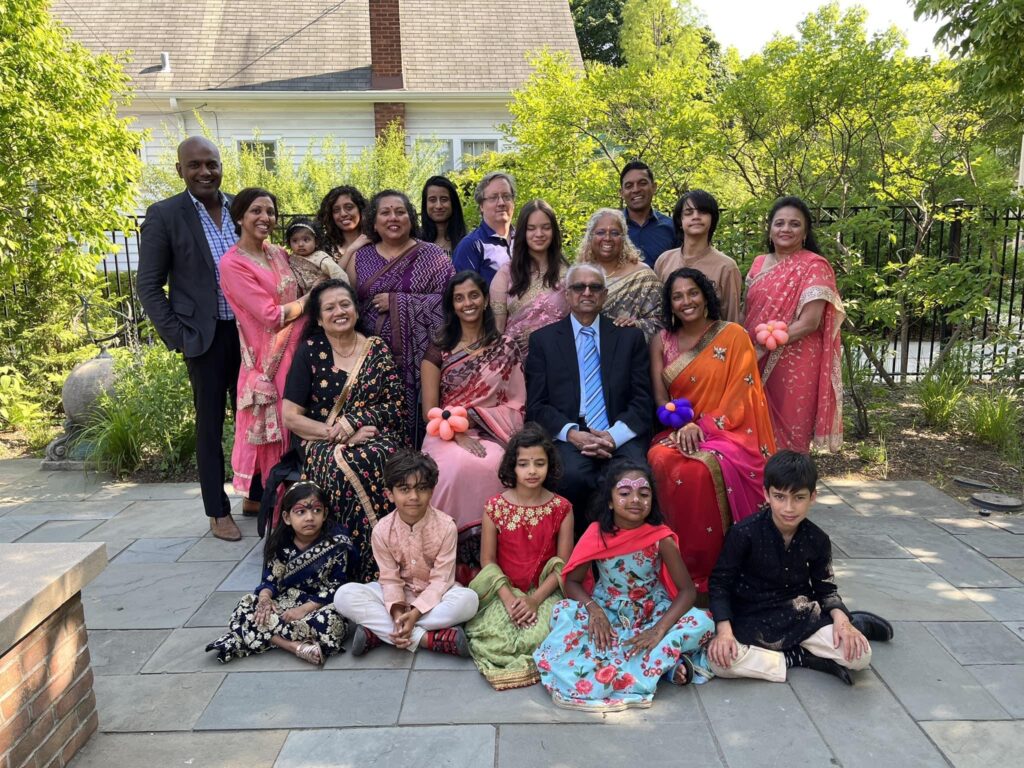Here’s all the family attending the party, and that’s a wrap on Kavi’s sari day, folks! At least until the professional photos show up… But let me take this opportunity to note that I kind of made up this holiday for Kavi.
I mean, not entirely — there are definitely parts of South Asia where girls celebrate Sari Day, sometimes with a whole class of 16-year-olds wearing saris for the first time, maybe at graduation. I ran into a young South Asian writer at Wiscon last weekend, and she noticed the mehndi on my hand, and when I mentioned it was from my daughter’s sari day, she said, “Oh! I know what that is!” So that was nice. ![]()
“People from South India traditionally follow a lovely ceremony known as “Saree Ceremony” or Rirusuddhi also known as Ritu Kala Samskara.” — https://katflowers.com.au/saree-ceremony/
Wikipedia has more: https://en.wikipedia.org/wiki/Ritu_Kala_Samskaram
It’s related to the half-sari ceremony. A half-sari is easier to wear than a sari, and wearing one is considered the first step into adulthood for girls, which traditionally occurred at puberty — my mother actually apologized to me that she wasn’t throwing me a party for that one, since we were in Connecticut, didn’t have a lot of South Asians around, etc.
I, age 10, was both horrified and grateful to be spared announcing to the world that I’d started menstruating.
In researching this, I was a little confused — some places seem to celebrate sari day as when you first wear a full sari; others, it’s when you first wear a half-sari (usually younger), and you wear the full sari only when you get married. I’m not sure it’s entirely culturally consistent one way or another.
***
Regardless, there are, of course, huge feminist issues with such ceremonies. I’m generally in favor of rites of adulthood, but when they’re mostly meant to let the men of the village know that this 12-year-old is ready to be wedded and bedded, it’s pretty icky.
“Essentially the custom is a traditional means of Sex education, to train and prepare a young girl to understand the body changes and the concept of adulthood. Historically a marriage or Sambandham starts soon after a girl celebrates this ceremony. This means she will be into a marital relationship at a very young age of 13 or 15 years old. Often due to this factor, Thirandukalyanam had a negative connotation among reformists who saw this ceremony as a way to get girls into such early marital relationships that restrict their social/educational opportunities.”
https://medium.com/…/the-half-sari-ceremony-or-the…
***
So we could have skipped it altogether. And it’s certainly annoying that there’s no parallel ceremony for boys, non-binary folks, gender-queer, etc. I may have to make something up for Anand at 16, if he wants one. Jewish culture does better at this, with a bar mitzvah and bat mitzvah.
A whole host of factors went into deciding to throw this party and celebrate the day despite that history, including things like:
- Kavi was seeing various of her friends having quinceañeras, and was a little envious; she really did want to be a pretty pretty princess for a day, and who can blame her? We should all get to be pretty pretty princesses for a day! (We don’t hang out in debutante circles, but that’s the same kind of thing.)
- I do think it’s important to mark transitions, and have family / cultural rituals that support that; if such traditions don’t exist, I’m pretty okay with inventing them — someone had to, at one point, after all.
- I wanted Kavi, as someone who is mixed race, to feel ownership and comfort in her cultural clothing and heritage, and I thought this would likely help; I think that part succeeded, and I hope she’ll be comfortable wearing saris for family weddings at least, going forward. They take some practice!
- it’s been a tough pandemic the last few years, and we all needed a party, a shindig, with a little hoopla and hullabaloo, a wild rumpus, as it were.
So there you go, Sari Day. Will my South Asian friends and relatives celebrate them with their daughters? I have no idea! But we had a great time. ![]()
***
NOTE: there is also World Saree Day — a completely different thing, a day to celebrate the beauty of the sari / saree: https://www.indiatoday.in/…/world-saree-day-2022-why-do…

